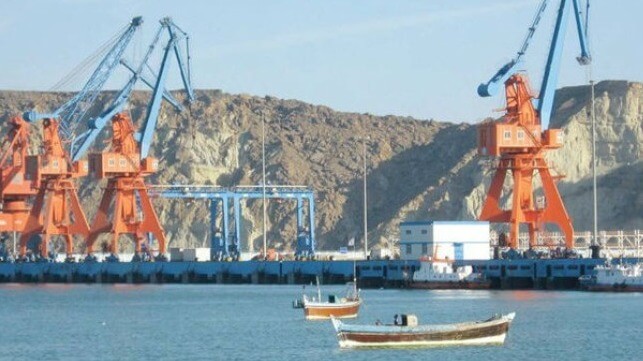Anti-China Protests in Gwadar May Evolve Into a Port Blockade
As a strategic economic investment for China, Gwadar is in jeopardy.

A couple of months back, 70-year-old housewife Masi Zainab asked a charismatic local political leader, Maulana Hidayat-ur-Rehman Baloch, to help mount a protest for the rights of the citizens of Gwadar, a port city in southwestern Pakistan. Within weeks, Masi Zainab was marching with thousands of women on the streets of the city, a first for this conservative society. Responding to the call, Rehman launched a sit-in protest on November 15.
The protest has gained global media attention because Gwadar represents both the starting point and center stage of China’s Belt and Road projects in Pakistan, referred to locally as the China–Pakistan Economic Corridor (CPEC). In this city of just 90,000 inhabitants, China has funded the construction of a deep seaport, airport, power plant and highways. Joint promotion of the city’s projects by Pakistan and China touts Gwadar as the Dubai or Singapore of the future.
Meanwhile, “Aunty” Zainab prepares food for the protesters, some of whom camped at the entrance to the Chinese-funded and operated Gwadar port for a month, far from the bustling metropolises of Pakistan. The protests have shaken mainstream media discourse in the country and its leader, Rehman, has become one of the most popular opposition figures in Pakistan.
The protests were based on two primary grievances, each of which have implications beyond the tiny port city of Gwadar. The first is a reduction in fishing opportunities, particularly important for a district where 65 per cent of the population are fishermen. Thousands of deep-sea fishing vessels, including some owned by Chinese companies, are devastating the fish population in the waters off Gwadar. Deep-sea fishing vessels use long fish-catching nets, which also catch eggs and small fish, leaving little for locals.
China’s demand for seafood is seemingly insatiable. According to a study by Stockholm University, China will require up to 18 million tons of additional seafood to satisfy its expected domestic consumption by 2030. In July this year, five Chinese deep-sea vessels were intercepted near Gwadar on suspicion of illegal fishing. The trawlers, subsequently found to be loaded with fish, were taken into custody by the Pakistan Maritime Security Agency. This incursion further aggravated protesters, who are now demanding a complete end to deep-sea fishing in the 12 nautical-mile sea limit off Gwadar.
The second reason for the protests is the plethora of issues experienced by local residents due to the security arrangements of Chinese personnel working on BRI projects. Chinese workers in Gwadar have been under attack by Baloch insurgents who blame China for the exploitation of their resources. As a result, Gwadar has been heavily militarized. Local residents must pass through numerous checkpoints on a daily basis, where they have to prove their identity and at times are refused passage. Recently, locals have resorted to protest against the daily humiliation of justifying their movements and have demanded an end to the security controls.
Despite multiple public demonstrations, the Pakistan government has not fulfilled any of the protesters’ demands, which also include improvements to water supply, electricity and roads. Pakistan’s Prime Minister Imran Khan announced in a tweet that he has taken notice, but there has been no concrete follow-up action. Now protesters say they will block operations of Chinese-controlled Gwadar port and its allied expressways. They have also announced a long march to the capital Islamabad if demands are not met.
Indirectly, Chinese interests in Gwadar have become a target of protesters’ demands. Although the demonstrations are not explicitly anti-Chinese, the demands put forth are in direct opposition to Chinese goals. For instance, Pakistan’s Senate was advised in late November that China would receive 91 per cent of the revenue generated by Gwadar port. Gwadar protesters led by Rehman are now demanding that 98 per cent of the revenue be retained by Gwadar and that only 2 percent goes to China. China has spent billions of dollars in Pakistan with the anticipation of substantial revenue from Gwadar port in the future.
The Gwadar sit-in protest was temporarily called off last week when the government announced it would accept the demands of protestors. The movement’s leader has said that if the government fails to implement the promised changes, they will protest again with more intensity.
Therefore, a complete blockage of the port is anticipated in the next phase. This will not only bring an end to the already limited cargo movement taking place at Gwadar port, but will also damage its reputation. After such upheaval, it will be hard to convince foreign investors that Gwadar is a secure and reliable bet. As a strategic economic investment for China, Gwadar is in jeopardy.
The opinions expressed herein are the author's and not necessarily those of The Maritime Executive.
